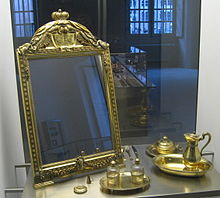March 03, 2017

The term gilding covers a number of decorative techniques for applying fine gold leaf or powder to solid surfaces such as wood, stone, or metal to give a thin coating of gold. A gilded object is also described as "gilt". Where metal is gilded, it was traditionally silver in the West, to make silver-gilt (or vermeil) objects, but gilt-bronze is commonly used in China, and also called ormolu if it is Western. Methods of gilding include hand application and glueing, chemical gilding, and electroplating, the last also called gold plating.[1] Parcel-gilt (partial gilt) objects are only gilded over part of their surfaces. This may mean that all of the inside, and none of the outside, of a chalice or similar vessel is gilded, or that patterns or images are made up by using a combination of gilt and un-gilt areas.
Herodotus mentions that the Egyptians gilded wood and metals, and many such objects have been excavated. Certain Ancient Greek statues of great prestige were chryselephantine, i.e., made of gold (for the clothing) and ivory (for the flesh); these however, were constructed with sheets of gold over a timber framework, not gilded. Extensive ornamental gilding was also used in the ceiling coffers of the Propylaea. Pliny the Elder informs us that the first gilding seen at Rome was after the destruction of Carthage, under the censorship of Lucius Mummius, when the Romans began to gild the ceilings of their temples and palaces, the Capitol being the first place on which this process was used. But he adds that luxury advanced on them so rapidly that in very little time you might see all, even private and poor people, gild the walls, vaults, and other parts of their dwellings. Owing to the comparative thickness of the gold leaf used in ancient gilding, the traces of it that remain are remarkably brilliant and solid. Fire-gilding of metal goes back at least to the 4th century BC, and was known to Pliny (33,20,64–5), Vitruvius (8,8,4) and in the Early Mediaeval period to Theophilus (De Diversis Artibus Book III).
In Europe, silver-gilt has always been more common than gilt-bronze, but in China the opposite has been the case. The ancient Chinese also developed the gilding of porcelain, which was later taken up by the French and other European potters.
Modern gilding is applied to numerous and diverse surfaces and by various processes; those used in modern technology are described in gold plating. More traditional techniques still form an important part of framemaking and are sometimes still employed in general woodworking, cabinet-work, decorative painting and interior decoration, bookbinding, and ornamental leather work, and in the decoration of pottery, porcelain, and glass.
Mechanical gilding includes all the operations in which gold leaf is prepared, and the processes to mechanically attach the gold onto surfaces. The techniques include burnishing, water gilding and oil-gilding used by wood carvers and gilders; and the gilding operations of the house decorator, sign painter, bookbinder, the paperstainer and several others.
Polished iron, steel and other metals are gilded mechanically by applying gold leaf to the metallic surface at a temperature just under red-hot, pressing the leaf on with a burnisher, then reheating when additional leaf may be laid on. The process is completed by cold burnishing.
"Overlaying" or folding or hammering on gold foil or gold leaf is the simplest and most ancient method, and is mentioned in Homer's Odyssey (Bk vi, 232),[2] and the Old Testament. The Ram in a Thicket of about 2600–2400 BCE from Ur uses this technique on wood, with a thin layer of bitumen underneath to help adhesion.
The next advances involved two simple processes. The first involves gold leaf, which is gold that is hammered or cut into very thin sheets. Gold leaf is often thinner than standard paper today, and when held to the light is semi-transparent; in ancient times it was typically about 10 times thicker than today, and perhaps half that in the Middle Ages.
If gilding on canvas or on wood, the surface was often first coated with gesso. "Gesso" is a substance made of finely ground gypsum or chalk mixed with glue. Once the coating of gesso had been applied, allowed to dry, and smoothed, it was re-wet with a sizing made of rabbit-skin glue and water ("water gilding", which allows the surface to be subsequently burnished to a mirror-like finish) or boiled linseed oil mixed with litharge ("oil gilding", which does not) and the gold leaf was layered on and left to dry. Those gilding on canvas and parchment also sometimes employed stiffly-beaten egg whites ("glair"), gum, and/ or Armenian bole as sizing, though egg whites and gum both become brittle over time, causing the gold leaf to crack and detach, and so honey was sometimes added to make them more flexible.
Other gilding processes involved using the gold as pigment in paint: the artist ground the gold into a fine powder and mixed it with a binder. Then the gold was applied in the same way as with any paint. Sometimes, after either gold-leafing or gold-painting, the artist would heat the piece enough to melt the gold slightly, ensuring an even coat. These techniques remained the only alternative for materials like wood, leather, and the vellum pages of illuminated manuscripts.

Chemical gilding embraces those processes in which the gold is at some stage of chemical combination. These include:
In this process the gold is obtained in a state of extremely fine division, and applied by mechanical means. Cold gilding on silver is performed by a solution of gold in aqua regia, applied by dipping a linen rag into the solution, burning it, and rubbing the black and heavy ashes on the silver with the finger or a piece of leather or cork.
Source: Wikipedia
